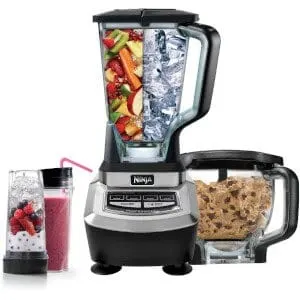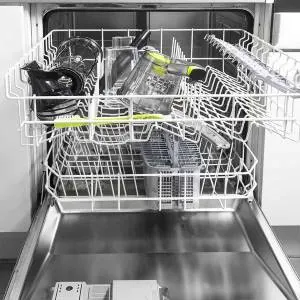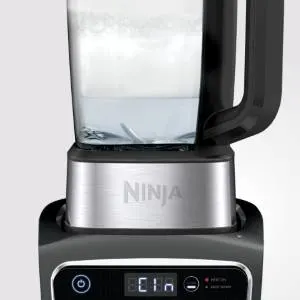 Ninja blenders are fabulous products. You can use these blenders for pretty much anything, from making smoothies to processing food. But can Ninja blenders go in the dishwasher? This is a big question with consumers, and today I am going to answer it for you.
Ninja blenders are fabulous products. You can use these blenders for pretty much anything, from making smoothies to processing food. But can Ninja blenders go in the dishwasher? This is a big question with consumers, and today I am going to answer it for you.
With such a remarkable list of capabilities, Ninja blenders are some of the most desired kitchen appliances in the world. They have powerful motors, durable blades, and impressive technology. And you will be happy to know they are very easy to clean.
In fact, almost all of the removable components of a Ninja blender can go in the dishwasher. They are absolutely dishwasher safe, and they can also be cleaned easily in the sink with some soap and water.
Read More: Best Ninja Blenders – 3 Top Rated Models
Can Ninja Blenders Go in the Dishwasher?
You can clean your Ninja blender using the dishwasher. This will work for almost all the removable parts of your blender. The blades, the container, and the lid are completely safe in the dishwasher. But before you start the cleaning process, make sure your blender is unplugged. Then you can start disassembling the appliance.
The first step is to take off the lid and add it to the dishwasher. Next, you can unsnap the blades and add the blade assembly to the dishwasher. The final action is to twist off the main container and then add that to the dishwasher. These are the three main components that can be cleaned.
It is important to note that you should never put the motor base in the dishwasher. It would be like putting a toaster in the dishwasher, it just doesn’t make any sense. When you clean the motor base, keep it away from water or other liquids, and only wipe it down with a damp cloth or rag. If you get water in the motor, it can cause irreversible damage.
When it comes to cleaning the main container, some people prefer using the dishwasher over the self-cleaning method. This is because when you allow the machine to clean itself, it still does not clean the outside of the container, which can be burdened with dust or old ingredients, like chunks of fruit or spilled smoothie juice.
Read More: Ninja Blender Not Working – Troubleshooting Problems & Fixes
When Should You Clean Your Ninja Blender?
If you aren’t sure when is a good time to clean your Ninja blender, basically, any time will do. If you have just made a thick banana smoothie, if you have just mashed some potatoes, or if you have just finished making your famous homemade tomato sauce, it is probably a good time to clean your Ninja blender.
In fact, you want to clean your blender after every use. There is no sense in using your Ninja blender without cleaning it. Even if you only made a simple green smoothie, there is going to be residue and gunk stuck to the sides of your container. This means you need to clean it after every usage.
However, it is not always necessary to take the blender apart to clean it. You can often use its self-cleaning feature rather than taking it apart and putting it in the dishwasher. When it comes to cleaning the other components, such as the base of the blender, it basically never needs to be done.
At most, you may want to remove the container and lightly wash the exposed components after a dozen or so uses. This will help to keep the moving parts free of dust and other debris. If too much dust clogs your blender or gets into the motor, it can cause heat issues and performance problems.
Read More: What to do if Your Ninja Blender Pitcher Cracked – Can it be Fixed?
Watch the Blades
 It is important that you always take care to watch the blender blades when doing your cleaning. Some blenders come with dull blades, but they are still pointy. Then there are some blades that are extremely sharp and can cause damage if you accidentally touch one with your hand.
It is important that you always take care to watch the blender blades when doing your cleaning. Some blenders come with dull blades, but they are still pointy. Then there are some blades that are extremely sharp and can cause damage if you accidentally touch one with your hand.
When cleaning the blades manually, it is important that you treat them like knives. Use a cloth and carefully clean each blade without touching the sharpened edge. However, you should never really have to clean the blades manually, as this can be done using the self-cleaning feature.
Should I Put the Blades in the Dishwasher?
Some people wash their Ninja blender blades in the dishwasher, and some people don’t. I personally do put the blades in the dishwasher, but only occasionally. The blades are made from metal, so they can be put in the dishwasher.
However, if you put your blades in the dishwasher on a regular basis, you will notice that they become dull over time. This is because exposure to water and other liquids will change the metal’s composition over time. It may not be as sharp as it was when first purchased, and it will most likely lose its sheen.
However, if you want to save money and retain the sharp blades, simply washing them by hand or with the self-cleaning program can be sufficient after every use. Once a month I will put the blades in my dishwasher to give them a deep clean, but no more than that.
The blade assembly must be removed from the pitcher before putting it in your dishwasher.
Read More: How To Use A Ninja Blender: Ultimate Assembly & Tips Guide
How to Clean Your Ninja Blender
Cleaning your Ninja blender is much simpler than you may think. If you take proper care of your blender, it will work for years to come. All Ninja products are incredibly safe, extremely durable, and they offer extreme performance quality. The same can be said for the Ninja blender container.
When you first purchase your Ninja blender, it will likely come with a three-year warranty. This is because Ninja truly stands behind its products and believes that they are built to last.
After purchasing your Ninja blender, simply follow these steps every time after use to keep everything in tip-top shape:
- Unplug the appliance. Make sure to immediately clean any dried or crusted ingredients out of this area before storing it away; otherwise, mold growth could result over time if left undisturbed.
- Detach all components from one another and wipe down each component thoroughly with a damp cloth. Place all containers, lids, and cups into the top rack of a dishwasher.
- Use a dry cloth to rub down any metal parts or components that have been exposed to water and then allow them to air dry.
- Place the blender blade into your dishwasher for a quick wash, but only if it’s safe to do so (most blades are fine if put in the dishwasher every once in a while). You can also clean this part manually using your sink or by running through the self-cleaning program.
- Reassemble all components of your Ninja Blender and store it away until your next use. Don’t forget to do this same process every time you use your blender, as leftover ingredients will only cause odors and unsightly stains if left unattended before the next use!
You may want to store your Ninja Blender in a cupboard or on the countertop for easy access, but be sure that it has ample space around it so that air can circulate properly. This will prevent odor build up over time.
If you follow these simple steps each time after use, then your Ninja Blender should provide many years of safe and efficient service for you and your family, no matter how often you use it!
Read More: How To Clean A Ninja Blender – 9 Simple Steps
Self-Cleaning
 One of my favorite features with any Ninja blender is the self-cleaning mode. Most Ninja blenders come with a minimum of a 1000-watt motor, which makes cleaning very efficient. This is very unlike personal blenders that have a hard time doing anything. The Ninja blender is so powerful that it can clean itself in about 60 seconds.
One of my favorite features with any Ninja blender is the self-cleaning mode. Most Ninja blenders come with a minimum of a 1000-watt motor, which makes cleaning very efficient. This is very unlike personal blenders that have a hard time doing anything. The Ninja blender is so powerful that it can clean itself in about 60 seconds.
To start this process, simply remove the lid and fill the container almost full with warm water. It is important not to fill the entire container, and to leave about 1/4 of the space empty. It is also important not to use hot water, since the friction of the fast-moving blades will keep the water at the perfect temperature.
This is very similar to how your Ninja blender is able to heat soup. There is so much friction created by the spinning blades that water can be boiled using your Ninja blender in under 10 minutes. All that force acts like a typhoon of soap to clean the interior of the container.
Once the blender is mostly full of water, you need to add several drops of dishwashing soap. Don’t squirt a lot in, as it is going to get extremely foamy inside the blender. Secure the lid and then activate the pulse button. You may need to hit the pulse button three or four times until the blender is sparkling clean.
Afterward, remove the lid, dump the water, and rinse the container. You may need to rinse and dump two or three times before all the soap is gone and your blender is sparkling clean. When the rinsing is done and your blender is perfect once again, simply remove the parts and place them on a towel so they can dry.
Read More: Ninja Blender Power Light Blinking: 5 Reasons and Fixes
Follow the Instructions
This article is a general overview regarding putting Ninja blenders in a dishwasher. There are many different models of Ninja blenders, so it is important to read the user manual that came with your particular model to ensure that you are using the dishwasher safely.
Remember, Ninja blenders have a lot of components – many more than just a standard blender. Make sure to follow the instructions provided by the manufacturer when doing this kind of thing or risk shortening the life of your Ninja blender.
Read More: Is Your Ninja Blender Lid Stuck? 7 Reasons & Solutions
Are Ninja Blenders Dishwasher Safe – Final Thoughts
The great thing about Ninja blenders is that they are all dishwasher safe. You can put all parts of the blender into the dishwasher (apart from the base of course!). The lids, containers, blades, and other accessories can all go straight into the top rack of a dishwasher. This is a great time-saver in an already busy household.
I hope this article has helped you learn how to clean your Ninja Blender. Cleaning is an important part of owning any appliance that potentially spills food out into the surrounding area.
I hope you’ve found this article interesting, and if you would like me to write about another kitchen topic specific to your interests, please let me know! I’m always looking for topics I can write about in more detail, so I’d love to hear from you.
Read More: How To Clean Vitamix Blenders: The Ultimate Guide
